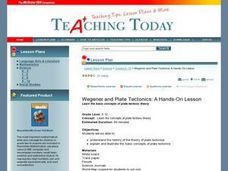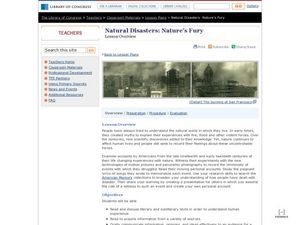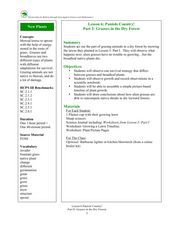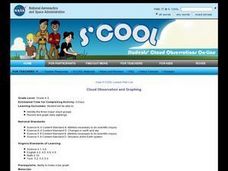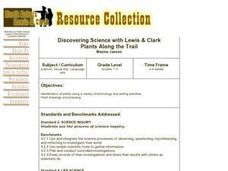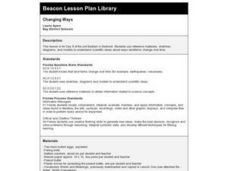Curated OER
Wegener and Plate Tectonics: A Hands-On Lesson
Students are introduced to and experiment with the basic concepts of plate tectonic theory as well as assess the history of the theory of plate tectonics. They explain and illustrate the basic concepts through diagrams and models of...
Curated OER
Lesson plan: History Underfoot
Students study Native Americans of Virginia. In this Virginia history lesson, students take on the role of archaeologists as they analyze a site and its artifacts. Students use the information to draw conclusions about the natives who...
Alabama Learning Exchange
What Color Are The Leaves?
Young scholars identify the colors in leaves. In this chromatography lesson, students read the book Why Do Leaves Change Color? and construct chromatography strips to identify the colors of leaves.
Curated OER
Volume, Surface Area for Rectangular & Triangular Prisms
Seventh graders explore the concept of rectangular and triangular prisms. In this rectangular and triangular prism instructional activity, 7th graders identify various prisms as triangular or rectangular. Students discuss the various...
Curated OER
Now You're Speaking My Language; Deciphering the Symbols of Early Civilizations
Young scholars explore early attempts at written language. In this early civilizations lesson, students investigate first attempts at written communication. Among the civilizations covered are Mayan, Greek, and Egyptian.
Curated OER
The More Things Change
Second graders discuss change in cities over time. They view pictures of a city as it has changed over time and then compare city pictures of the past to those of a modern city today. In preparing for a guest speaker who will come and...
Curated OER
Natural Disasters: Nature's Fury
Students explore the human experience. For this business ethics lesson, students analyze primary sources to develop an understanding of the American natural disasters of the 19th and 20th centuries and the implications they presented.
Curated OER
Lesson 6: Paniolo Country Grazers in the Dry Forest
Learners explore grazing animals in a dry forest. In this science lesson, students act out the role of a grazer in the dry forest. Learners cut their growing lawn and observe what happens after being cut. Students explore differences...
Curated OER
Integrated Social Studies and Storytelling Lesson
Fourth graders study the Civil War. They examine online photos that are connected to Indiana's role in the Civil War. They choose one of these photos and in a story circle, tell a story about it. They tell who is in the picture, what...
Curated OER
Cloud Observation and Graphing
Students identify the three major cloud groups. They are introduced to the three main cloud types and spend a week making and recording observations of clouds. Students produce a graph that presents their findings and conduct research...
Curated OER
Heat Transfer and Pollution
Pupils perform computer simulations on air dispersion. In this chemistry lesson plan, students calculate energy transfer based on specific heat and temperature change. They explain the causes of smog.
Curated OER
Discovering Science with Lewis & Clark
Learners photograph plants and contribute their pictures to a class powerpoin on plant variety.
Curated OER
The Wind-Up and the Pitch
Students consider how sound affects one's experience at a ballpark and the ways that the acoustics at a baseball stadium might be improved. Students then recommend their own designs for a "soundly built" baseball stadium.
Curated OER
Which Way to Roots Grow?
Second graders explore roots and how they grow. They observe as seeds planted in various directions grow and record their observations. Students discuss the direction in which the roots are growing.
Curated OER
Robert Boyle and the Royal Society
Students research Royal Society, explain reasons for its foundation, examine reasons why it is beneficial to modern scientists to work in teams, and identify ways scientists disseminate information.
Curated OER
The Penny Factory
Fourth graders identify the characteristics of a simple physical and chemical change. They describe objects by the properties of the materials from which they are made and separate or sort items using these properties. Students explain...
Curated OER
Green Leaves
Third graders, after having conducted one experiment three times, record their observations results in a chart. They predict what hidden colors they believe that a leaf holds. Students record their predictions in their science note books...
Curated OER
Changing Ways
Third graders examine hard boiled eggs as possible models for the earth's layers.
Curated OER
Household ProductsPast to Future
Third graders research and explore the development of household inventions. Groups create timelines which must display the date of each contribution, the inventor or inventors of each contribution, and the cultural background of each...
Curated OER
Adapted to Fire
Fourth graders explore forest species' adaptations to fire by participating in a scavenger hunt and mapping a burned forest. Students create maps and explore how indigenous species adapted to living with fire.
Curated OER
Butterfly Life Cycle
Third graders investigate the life cycle and development of butterflies. They complete an online WebQuest, and write journal entries about their research information. Students create a poster, and observe real Painted Lady larvae...
Curated OER
Soaring Through Space With a Kid Pix Slide Show
First graders create a slide show on Kid Pix about space. In this space lesson plan, 1st graders will explore the earth, sun, moon, and planets. After exploring their motions and locations around the sun, they create a 4 page slide show...
Curated OER
Exploring With Photograms
Students observe the interaction between energy absorbed, reflected or transmitted through an object in a photochemical process with a classroom demonstration.
Curated OER
Tulips: Predicting the Arrival of Spring
Middle schoolers use the blooming of tulips as a tool to measure spring's journey north. They predict when tulips bloom at 13 selected Journey North gardens in various geographic regions.
